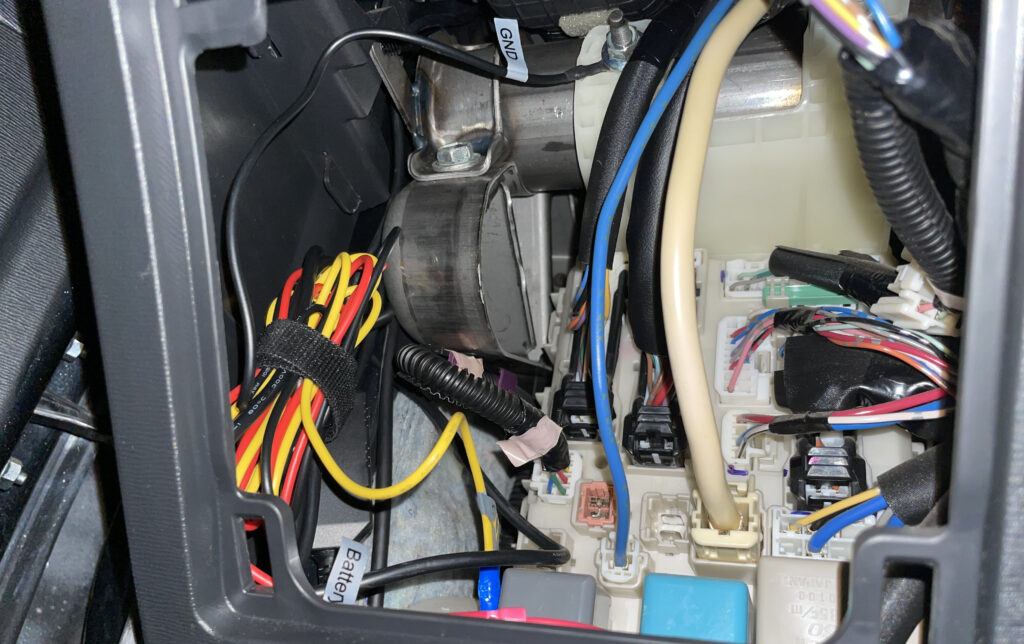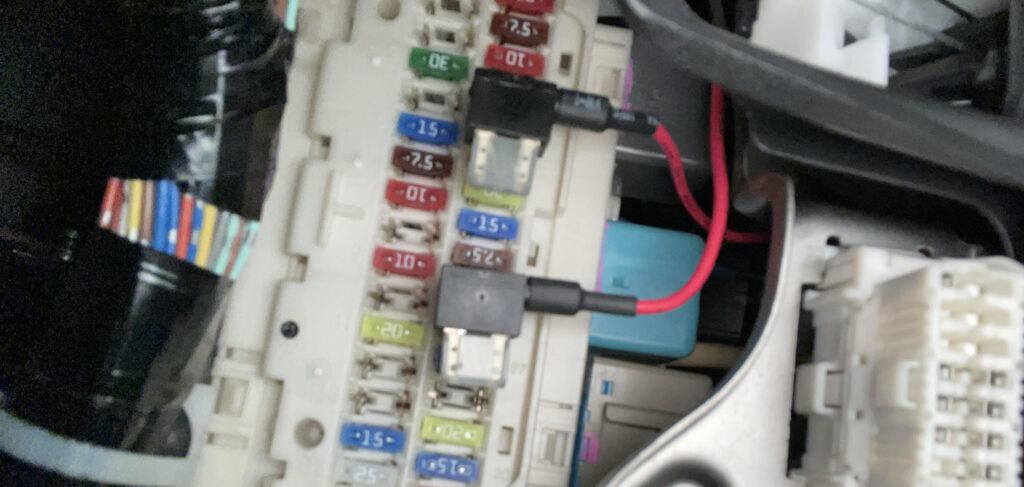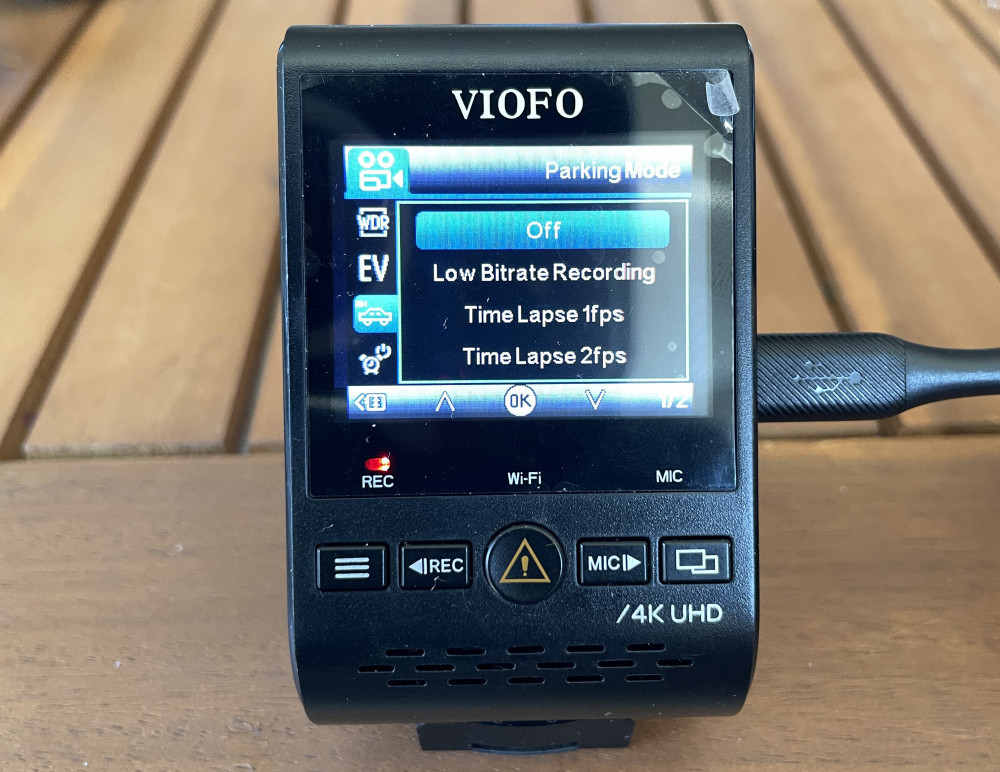If you’re researching dash cams, then you’ve probably come across the term “Parking Mode” as a feature of many dash cams and wondered to yourself, “What is parking mode?” In this post I’ll explain what parking mode is, why you want it, and its strengths and weaknesses.
Parking Mode Explained
Put simply, parking mode allows your dash cam to record while your car engine isn’t running and presumably while you’re away from your car.
How Parking Mode Works – A Hardwire Kit Provides the Magic Sauce

Viofo HK3 hardwire kit wires bundled together.
Parking Mode works by using what’s called a hardwire kit. This kit draws power from your car’s starter battery and subsequently uses that power to feed the dash cam.
The hardwire kit has a specialized circuit that will stop drawing power from your car’s starter battery should voltage drop below the voltage cutoff threshold. This cutoff is to prevent your dash cam from draining your car’s starter battery to the point that you can no longer start your car.
Hardwire Kit Installation Steps
A hardwire kit usually consists of three wires: a ground, ACC, and BATT wire. The ground connects to a ground point on your car, the ACC wire connects to a slot in your car’s fuse box, via a fuse tap, that only receives power while your car is running, and the BATT wire connects to a slot in your car’s fuse box, via a fuse tap, that is always hot, or in other words, receives power both when your car is running and turned off.
Fuse Taps – An Easy and Non-Intrusive Way To Connect to Your Car’s Fuse Box

Two fuse taps installed into a fuse box.
The hardwire kit wires typically connect to your cars fuse box through the use of fuse taps which allow you to piggy-back off of other circuits in your car’s fuse box or to easily use an empty fuse slot.
Your dash cam, in conjunction with the hardwire kit, will be able to detect when your car is off and on through the use of the ACC/accessory wire. When you turn your car off, your hardwire kit/dash cam will detect the loss of ACC voltage and transition into parking mode.
Different Recording Settings in Parking Mode
While in parking mode, your dash cam will record in either a lower bit rate, resolution, or both in order to provide the longest possible coverage before it starts to overwrite the oldest parking mode recordings. The parking mode settings are usually user configurable.
Some dash cams offer a setting where it uses an algorithm to detect motion and will move a recording from memory to disk when it does detect motion. Viofo calls this Auto Event Detection, but other manufacturers may call it something different.
My personal experience matches that of others in that Auto Event Detection doesn’t catch everything that happens. Oftentimes, you’ll see people “appear out of nowhere” in your parking mode footage.
Obviously, people don’t teleport themselves into the middle of your dash cams field of view, so one can deduce that the dash cam failed to record footage of the person walking to that position.
Why You Want Parking Mode
You want Parking Mode because it will record events that happen around your car when you’re not present. Obvious examples include someone:
- backing into your car.
- rear ending your car.
- sideswiping your car,
- breaking into your car, etc.
If you come back to your car and notice damage, then you can check the dash cam for possible evidence of what happened and use it to your advantage to hold the people who caused the damage financially responsible.
If you’re purchasing a dash cam, you might as well buy one that will help protect your car both when you are and are not driving.
Parking Mode Weaknesses
Parking Mode Can’t Capture Events that Happen off Camera
As great as parking mode is, it does have its weaknesses. One of the main weaknesses is that parking mode will only record footage within the field of view (FOV) of your dash cam’s cameras.
If you only have a forwarding facing camera, then it will only cover the front of your car. If you have a dual camera, then you’ll have footage of what happens in both the front and rear of your car.
Unfortunately, this means that the sides of your car are completely naked when it comes to dash cam coverage. Door dingers can bang and scratch your car doors to their heart’s content without you capturing them on camera.
If you want coverage of the sides of your vehicle, then you would need to install more dash cams. The only exception to this is if your dash cam offers a third camera that record your car’s passenger cabin. This may provide some view into what is happening on the sides of your cars, but may still have blind spots.
Parking Mode Won’t Work Without Power
Another weakness is that parking mode will only last as long as your starter battery has enough juice to remain above the hardwire kit’s voltage cutoff setting. For my car and dash cam, this meant I had about 15 – 16 hours of parking mode coverage before the hardwire kit would power off my dash cam.
Assuming you’re able to get a similar amount of parking coverage, this 15 -16 hours may be fine if you’re driving every day to recharge your starter battery, but if you don’t drive every day then you quickly lose the advantage of having parking mode. To get around this limitation you would have to use an external battery pack to provide additional power.
You Can Lose Footage Once Parking Mode Starts Overwriting the Oldest Files
Finally, even if you have enough power to keep your dash cam running in parking mode, eventually you’ll run out of storage space on your microSD card. This means you will need to check on your car before your dash cam starts overwriting parking mode footage to ensure it doesn’t overwrite footage of something happening to your car.
G-Force Settings Can Lock Parking Mode Recordings
Dash cams do come with a setting called G-force that will cause the dash cam to lock a recording and keep it from being deleted should the dash cam detect a certain amount of force. This will prevent the dash cam from overwriting these files, but you’re relying on the dash cam to detect a force that may or may not trigger the file lock.
I recommend testing out the Parking Mode feature to find out how long it will record before overwriting the oldest files and then checking on your car before that interval. This will ensure you spot damage to your car and can check your dash cam for the footage even if the G-Force sensor doesn’t lock the file.
Conclusion
To wrap up, parking mode is a feature that extends dash camera coverage to your car even while you’re not driving it.
This is beneficial in the event that something happens to your car within view of your dash cam’s cameras, but if something happens outside of that FOV, then you’re out of luck.
You may need additional power sources depending on how long your car goes without running and you’ll need to check your memory card periodically before your dash cam starts overwriting it.
Please leave any questions or comments you have and I’ll be sure to respond to them.
